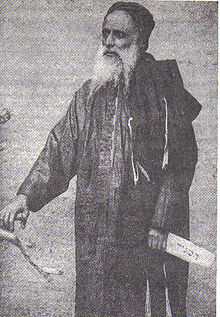Hayyim Habshush
Rabbi Hayyim Habshush, alternate spelling, Hibshush (Hebrew: ר` חיים בן יויא חבשוש also Hayyim ibn Yahya Habshush) (c. 1833–1899) was a coppersmith by trade,[1] and a noted nineteenth century historiographer of Yemenite Jewry.[2] He also served as a guide for the Jewish-French Orientalist and traveler Joseph Halévy. Some twenty three years later (in 1893), Hibshush began to write an account of Halévy’s journey, first in Hebrew, and then, at the request of Eduard Glaser, in his native language, the Judæo-Arabic dialect of Yemen.[3] As a prominent member of the Jewish community in Yemen, R' Habshush served as one of the principal leaders of the Dor Deah movement alongside Rabbi Yiḥyah Qafiḥ,[4] and Sa'id 'Arusi.[5]

The Hibshush family is one of earliest known Jewish families to have settled in Yemen, as he mentions the family living in Yemen before the advent of Islam, and who, along with four other Jewish families (al-Bishārī, al-Futayḥī, al-‘Uzayrī and al-Marḥabī) served the illustrious Sasson Halevi who had recently moved to Yemen from Iraq (Babylonia).[6] Sassoon Halevi is the progenitor of the renowned Alsheikh Halevi families, as well as the Yitzḥaq Halevi families, the former of whom rose to prominence after the Mawza Exile, and the latter of whom produced one of the last judges of the rabbinic court at Sana'a, Rabbi Yiḥya Yitzḥaq Halevi. The Hibshush family was originally called by the surname al-Futayḥī. In Yemen, however, Jews would address the family by the name of "Hibshush," while Muslims would say "Habshush."
In 1870, Hayyim Hibshush accompanied Joseph Halévy on an exploratory mission to the city of Saadah and in the regions thereabout. In the book Masa'ot Hibshush (Travels of Hibshush), he mentions the city of Tilmaṣ as being the old city of Saadah. He brings down an old Yemeni rhymed proverb: אדא אנת מן מלץ פאנא מן תלמץ = "If you are evasive (Ar. malaṣ), then I am from Tilmaṣ" (i.e. Saadah[7]). The importance of this revelation lies in the fact that scholars were heretofore uncertain about the place called "Tilmas" in Benjamin of Tudela's Itinerary, mentioned alongside Tayma, and where two Jewish brothers were allegedly the princes and governors over those places in the 12th century. The one is in present-day Saudi-Arabia, while the other in Yemen.
Published works
- Masot Habshush (Hebrew: מסעות חבשוש lit. "The Journeys of Habshush" ) The travels of R' Hayyim ben Yahya alongside Joseph Halévy in Yemen and the life of Arabs and Jews living there (republished in 1941 as edited by S.D. Goitein).
- Korot Yisrael b'Teiman (Hebrew: קורות ישראל בתימן lit. "The Annals of the Israelites in Yemen") A history of the Jews in Yemen during the 17th and 18th Century CE, believed to be a recension of an earlier work composed by chronicler, Yahya b. Judah Sa'di, and to which Hibshush added his own chronologies. The work is most noted for its detailed description of the Exile of Mawza (Galut Mawza) in 1679-1680.[8]
References
- ↑ The Fergusonian Impact. By Charles Albert Ferguson, Joshua A. Fishman. Published by Walter de Gruyter, 1986. p. 214.
- ↑ The Jews of the British Crown Colony of Aden: History, Culture, and Ethnic Relations. By Reuben Ahroni. Published by BRILL, 1994. p. 47.
- ↑ Linguistic Observations on a Native Yemenite by Wolf Leslau. The Jewish Quarterly Review, New Series, Vol. 36, No. 3 (Jan., 1946), Published by: University of Pennsylvania Press. p. 261.
- ↑ The Road to Redemption: The Jews of the Yemen, 1900-1950. By Tudor Parfitt. Published by BRILL, 1996. p. 46.
- ↑ The Jews of Yemen in the Nineteenth Century: A Portrait of a Messianic Community. By Klorman, Bat-Zion Eraqi Klorman. Published by BRILL, 1993. p. 162
- ↑ Hayim Hibshush, Masa'ot Hibshush, Jerusalem 1983, p. 353
- ↑ Saada was called in Hibshush's time, "Wadi Tilmaṣ."
- ↑ Shelomo Dov Goitein, The Yemenites (History, Communal Organization, Spiritual Life), Ben-Zvi Institute: Jerusalem 1983, p. 162 (Hebrew). David Solomon Sassoon attributes the writing to [the son of] Sa‘īd, based on the author’s own remark that he is “the son of Ḥazmaq the younger” (= Sa‘īd, or Se‘adyah), the usual rendition for this name given in the reversed order of the Hebrew alphabet. See: David Solomon Sassoon, Ohel Dawid (vol. 2), Oxford University Press: London 1932, p. 969, s.v. דופי הזמן
See also
- Yemenite Jews
- Dor Daim
- Dor Daim and Iqshim
- R' Yihya Qafih
|